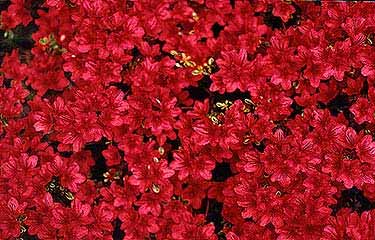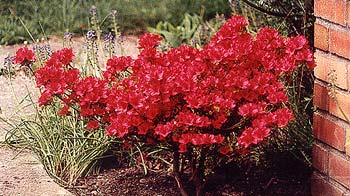 'Hino Crimson,'
'Hino Crimson,'
a tiny-leafed Azalea
"In joy or sadness,
flowers are our constant friends."
-Kazuko Okakura
(1862-1913)
(1862-1913)
Several of the Rhododendron obtusum hybrids have smallish, single, brilliantly red blooms. 'Hino Crimson' is the best known in this group of Azaleas, a recipient of the Award for Garden Merit given only to plants that have over time proven their hardiness & lasting popularity. It has an upright stance reaching three feet in ten years; I've seen old specimens much taller.
The trait I find most charming about Hino Crimson is its teency-tiny leaves half or a third the size of other small-leafed dwarfs, though not all strains have this feature. The Hino Crimsons & their copycats like 'Red Red' which are mass-produced for cheap sales always seem to have bigger (two inch) dwarf leaves, a simpler straight limb structure, & often a flattened low growth. Nice enough but nothing I would have give the Award for Garden Merit.
 But I saw several mature specimens in an old garden that despite their age had the thinnest most elaborately forking & re-forking limb structure, standing upright to three & four feet & no wider, & rather open revealing its limb structure, plus the eenciest leaves mostly only a half-inch. It made much more sense that that was the form of the shrub that had earned the AGM. I am pretty much convinced when the Award for Garden Merit was given, Hino Crimson tended more often to resemble this splendid tiny-leaf crooked-limbed shrub, but haphazard overproduction has resulted in a more workmanlike shrub being sold under the popular name.
But I saw several mature specimens in an old garden that despite their age had the thinnest most elaborately forking & re-forking limb structure, standing upright to three & four feet & no wider, & rather open revealing its limb structure, plus the eenciest leaves mostly only a half-inch. It made much more sense that that was the form of the shrub that had earned the AGM. I am pretty much convinced when the Award for Garden Merit was given, Hino Crimson tended more often to resemble this splendid tiny-leaf crooked-limbed shrub, but haphazard overproduction has resulted in a more workmanlike shrub being sold under the popular name.I kept seeing the most remarkable specimens in established gardens, but it took a while to find an ideal example for sale. Then one spring day in one of the nicer nurseries, Granny Artemis pointed at a three gallon pot with an azalea speckled all over with the smallest brightest red buds, & she exclaimed, "There it is! The tiny leaves!" Unlike the chain hardware store imitation Hino Crimsons for $1.95 in gallon pots, this one was rather expensive, but was exactly what we wanted so worth every penny. The leaves were mostly in the half-inch range & not too compact to reveal the refined tightly branching limb structure.
It is in full bright bud throughout April & in some ways this is its best month, as the leaves & limbs are still visible but the colorfulness of the buds makes for an extremely red peppering. In early May the flowers will be so dense the shrub is for a while completely hidden.
The little leaves are shiny deep green most of the year, except in winter, when they take on a bronze coloration. The original species is native of Kurume, Japan, & cultivars derived from R. obtusum are called Kurume hybrids. Hino Crimson specifically was hybridized in America in 1940, from plants imported from Japan to the Arnold Arboretum in Boston in 1919. Its specific parents were two similar cultivars of R. obtusum, namely 'Amoenum' pollinated by 'Hinode-giri.'
Hino Crimson prefers half to full sun & can sometimes languish in shade. We planted ours at the foot of the steps by the front door, in front of a big hawthorne shrub & amidst the grape hyacinths which are still in full bright blue bloom alongside the first brilliantly scarlet Hino Crimson buds, making for a striking contrast. During a record-hot summer, however, I decided this full-sun location had proven too stressful, so I moved our first Hino Crimson to a better sheltered location where it gets a good dose of sun in the afternoon. Yet I somehow ended up planting another Hino Crimson in the same location where our first one started.